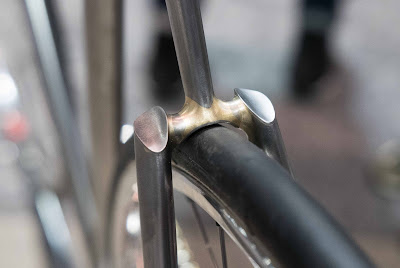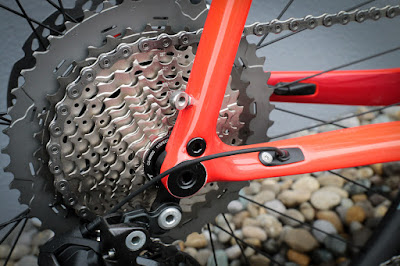by Igor
Gerard (Gerry as we've been calling him at HQ) has turned out to be one spry 61 year old.
He has scrapes, bumps, and "that wasn't there yesterday"'s that not only show his age, but describe a life of use and care. Whoever used this bike before me, really enjoyed it.
While working on this bike, I was frequently reminded of the old Japanese pottery repair technique, Kintsugi.
Kintsugi is a philosophy that lets imperfections and breakages literally shine rather than attempt to disguise them. Gold or platinum dust is included in the lacquer used for repair work, creating beautiful, gleaming veins that allow the piece's history to be at the forefront of one's attention. Interestingly, this technique got so popular, collectors started smashing brand new pottery in order to replicate the style.
Gerard was rebuilt with simplicity in mind. The wheels are sturdy and built to last. The rear is a 32 hole
Fixed Hub laced to a
650b Diagonale Rim while the front is a
Grand Cru High Flange Front Hub laced to the same. The rear is spaced 120mm so the rear wheel's hub fits without any issues, while the front is 96mm (typical of old French bikes). No biggie, the front hub gets crammed in.
Gearing is midrange: 44 tooth 50.4 chaining paired to an 18 tooth rear cog. This setup makes around town jaunts with a load easy while minimizing spinning out on slightly longer rides. Tires are cushy Panaracer Pari-Motos in the 42mm sizeway.
The bottom bracket shell is French threaded (drive side and non-drive side both tighten clockwise) so I used our
French Threaded Bottom Bracket with a 118mm spindle.
A proper French bike cannot be left without fenders.
52mm Zeppelins wrap perfectly and provide optimal coverage. A clever, little
Spring Thing keeps a nice fenderline with the frame's long, horizontal dropouts.
The
Porteur Rack is fitted close to the fender by trimming the lower tangs. The rack is further mounted to the fender in Constructeur fashion.
The
Sabot Pedals are my go-to. They're chunky, spinny, grippy, elegant, and look right on this traditional build.
Handlebars are the 23.8mm
Left Banks with NOS CLB city levers (what the
Tektro FL750 levers are modeled after). Grips are the ever comfy and classic
Rustines Constructeur in black. Brake cabling is our
Stainless Steel Wound kit along with some
Step-Down Housing Caps for the brake levers and frame cable stops.
The
Grand Cru Quill Stem needed a tad bit of sanding to fit into the steerer. Clint did a
nice write-up about fitting 22.2mm stems into 22.0mm French steerers. A few minutes worth of sanding allowed the quill to fit in and stay secure. A silver
Brass Temple Bell adorns the stem in traditional constructeur fashion.
Atop the 25.4mm
Dajia 1b Seatpost is an old Brooks perch. I got the saddle when we picked up our Santana Arriva Tandem. I believe it's from the mid-80s. I think it might be too far gone to be remolded, but it sure looks cool!
The brakes were disassembled, cleaned and new
Kool Stop 4-dot Pads were fitted. How do they stop? They stop, more or less. Mostly less. They modulate speed, that's where I'll leave it.
The showstopper here is this vintage, gorgeous chainguard. We've had in it in our showroom's display case for years, waiting for just the right build. The original paint and patina is perfect for Gerard. The frame has a single mount on the downtube. For the seat tube, I used our
Chainguard Mounting Hardware and a bit of cloth tape to protect the tube.
A
Porteur Double Leg Kickstand keeps the bike upright and ready for loading.
Experiencing the history, care, and continued service of something so connected as a bicycle and its rider is a wonderful thing to behold: scuffed crankarms from miles and miles of tours, lived in bar tape, saddle with corner tears from taking a gravel laden corner too fast, scratched top tube from that darn sharp sign post I always forget about, and random paint chips from heck knows where. Having a beautifully new paint job is nice, but I don't think babying is the way to go. Embrace the scratches, scuffs, and imperfections, and enjoy your ride.






































